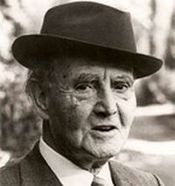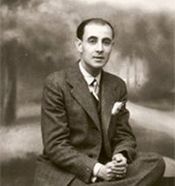Timeline
1893
Born in Sarrià (Barcelona), on the 28th of January.
1901
Attends the municipal school run by D. Salvador Mundi, master of the came, where he creates the newspaper Lo Català along with Josep Obiols.
1905-1907
Writes in a En Patufet, where he tends to use a pseudonym.
1911
He begins his oeuvre in the guise of a diary in notebooks with black oilcloth covers. He enters the university in the Faculty of Law. His zeal for reading the classics, along with a spiritual crisis and a crisis in orientation influence his decision to quit school in his second year. He works in a typographic letter foundry purchased by his father.
1916
He forges his first contact with the French and Italian avant-garde movements.
1917
Thanks to his friendship with Joaquim Folguera, he starts contributing to La Revista, edited by Josep M. López Picó. He meets Joan Miró, with whom he would forge a close friendship.
1918
He starts his visits to Sitges, where he meets Josep Carbonell i Gener. He edits the last editions of the avant-garde magazine Trossos. Before him it had been edited by Josep M. Junoy.
1919-1920
He is part of the editorial staff of La Cònsola a magazin from Sarrià where several of his contributions appear, although not always under his own name. Thanks to his mediation, the magazine publishes contributions from other poets, including Riba, Carner and Ventura Gassol.
1920
He publishes “El poema de Catalunya” in La Cònsola. This is one of the few visual poems he left.
1921
He serves as editor-in-chief of the magazine Monitor along with Josep Carbonell i Gener.
1922
He is a member of the group that founds Acció Catalana, and he writes the first few editions of the newsletter.
He begins to contribute to the newspaper La Publicitat, where he would write until 1936.
1923
He opens the Foix confectionary in Plaza de Sarrià.
1924
He starts his stays in Port de la Selva, where Alexandre Plana, Josep M. de Sagarra and other writers were already going.
1925
He meets Salvador Dalí.
He contributes to Revista de Poesia.
1926
He joins the editorial staff of L’Amic de les Arts from Sitges.
Presentation of the Salvador Dalí exhibition in Galeries Dalmau on Barcelona’s Passeig de Gràcia.
1927
Publication of his first book of poems in prose, Gertrudis, which Joan Miró illustrates with an original drawing.
1931
He marries Victòria Gili i Serra. The couple separates in 1948.
1932
KRTU, his second book, appears. He takes part in founding the group ADLAN (Amics de l’Art Nou).
1933
Catalan delegate to the PEN CLUB Congress which is held in Dubrovnik (Yugoslavia).
1934
Along with Josep Carbonell he publishes Revolució Catalanista, a series of articles that express both authors’ political ideas. He serves as the editor-in-chief in the third stage of the Revista de Catalunya.
Becomes the editor of the literary page of La Publicitat. He alternates signing articles using his real name and Fòcius and other pseudonyms.
1935
Along with Carles Riba, Tomàs Garcés, Marià Manent and Joan Teixidor he founds the magazine Quaderns de Poesia.
1944
He contributes to Poesia, the magazine edited by Josep Palau i Fabre.
1946
He contributes to the magazine Ariel.
Presentation at the Centre Excursionista “Els Blaus de Sarrià” of the exhibition on Joan Ponç, Tort, Puig and Boadella.
1947
With the date of 1936, he publishes the book of sonnets Sol, i de dol, which over the years will become paradigmatic.
1948
Contributes to the magazine published by the group Dau al Set of the same name.
1949
J.V. Foix’s most cryptic book Les irreals omegues, appears. The majority of the poems refer to the Civil War and the post-war period.
1952
He attends the Poetry Congress of Segovia with other Catalan poets. Embarks on a friendship with Vicente Aleixandre.
1953
He participates in the Poetry Congress of Salamanca. Publishes a new book of poems: On he deixat les claus.
1956
He publishes some of the poems started in 1911 under the title Del Diari de 1918, with a prologue by Josep Romeu Figueras.
1959
Poetry Congress of Formentor.
1960
In the book Onze Nadals i un Cap d’Any he compiles the Christmas poems that he sent to his friends.
1961
He is named member of the Institut d’Estudis Catalans, Philology Section.
He receives the Lletra d’Or or the publication of this book. He contributes anonymously to the magazine Serra d’Or.
1962
He is named full member of the l’Institut d’Estudis Catalans, Philology Section.
He presides over the Catalan delegation that attends the COMES Congress (Comunità Europea degli Scrittori) in Florence.
1963
L’estrella d’En Perris appears, where he pursues the style of poems in prose, which are part of the Del Diari de 1918 project.
1964
He publishes the volume Obres poètiques his complete poems and prose, where he includes as the prologue “Lletra a Clara Sobirós”, the utmost expression of his poetics. He also adds the poems that are part of the book Desa aquests llibres al calaix de baix as well as other hitherto unpublished poems.
1965
He publishes Catalans de 1918, literary portraits of his masters and contemporaries, with a prologue by Joan Colomines. Escenificació de cinc poemes appears, a book where he adapts five poems from L’estrella d’En Perris for the theatre. The illustrations in this edition are by Pla-Narbona.
1966
He is awarded the National Prize for Catalan Literature.
1969
In Els lloms transparents he compiles the articles he published in La Publicitat. The prologue is written by Gabriel Ferrater.
1970
He publishes arrer Comunicat, a new book of poems from Del Diari de 1918. Allò que no diu La Vanguardia appears, a book made up of his prose piecesfrom the “Telegrames” section of the La Publicitat in addition to new brief poems. La pell de la pell
1971
He publishes Mots i maons o cascú el seu, a book of thoughts on poetry and architecture.
1972
Desa aquests llibres al calaix de baix is published in a volume of its own. A new book of poems in prose is released: Tocant a mà. The cantata “A cal fuster hi ha novetat” is launched at the Palau de la Música Catalana. Text by J.V. Foix and music by Narcís Bonet.
1973
He turns 80 years old an embarks on a stage of unanimous acclaim. He wins the Premi d’Honor de les Lletres Catalanes.
1974
FAD (Foment de les Arts Decoratives) grants him the Medal of Honour. He publishes 97 notes sobre ficcions poncianes illustrated by Joan Ponç. The first volume of his complete works is released: Obres Completes. Poesia. It has an introduction by Pere Gimferrer.
1978
He serves as the honorary president of the PEN Club in Barcelona.
1979
The second volume of his complete works is released: Obres Completes. Prosa.
1980
He receives the Serra d’Or Critic’s award. The Barcelona Town Hall awards him the City’s Golden Medal.
1981
The Generalitat de Catalunya grants him the Golden Medal.
1984
The French government decorates him and names him a Chevalier de l’Ordre des Arts et des Lettres. The Universidad de Barcelona grants him the degree of Doctor Honoris Causa. L’Estació appears, with engravings by Antoni Tàpies. He is awarded the Premio Nacional de las Letras for his entire oeuvre.
1986
He wins the Ciutat de Barcelona prize for his last book, Cròniques de l’Ultrason.
1987
He dies on the 29th of January. He had turned 94 years old the day before.
Contact
Inquiries
Verses of the day
Forts en el fort i assetjats per Ningú, / Ens ombrejava una sola bandera.
Links
Libraries
Homes of catalan writers
© 2025 Fundació JV Foix































